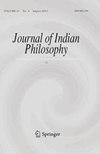阿内坎塔瓦达的两种用途
IF 0.3
2区 哲学
0 ASIAN STUDIES
引用次数: 0
摘要
我将提出的论点是,无论其确切起源如何,anekāntavāda 主要(尽管不是唯一)用于两个目的:(1) 解决 "因果性悖论",(2) 对非耆那教思想体系进行分类。出现该学说的最早文本将其作为因果悖论的解决方案。后来,我们才发现它被用来对非耆那教哲学进行分类。本文章由计算机程序翻译,如有差异,请以英文原文为准。
Two Uses of Anekāntavāda
The thesis I will present is that, whatever its exact origins, the anekāntavāda was primarily (though not exclusively) used for two purposes: (1) to solve the “paradox of causality”, and (2) to classify non-Jaina systems of thought. The earliest texts in which the doctrine occurs present it as a solution to the paradox of causality. Only later do we find its use to classify non-Jaina philosophies.
求助全文
通过发布文献求助,成功后即可免费获取论文全文。
去求助
来源期刊

JOURNAL OF INDIAN PHILOSOPHY
Multiple-
CiteScore
0.80
自引率
0.00%
发文量
32
期刊介绍:
The Journal of Indian Philosophy publishes articles on various aspects of Indian thought, classical and modern. Articles range from close analysis of individual philosophical texts to detailed annotated translations of texts. The journal also publishes more speculative discussions of philosophical issues based on a close reading of primary sources.
 求助内容:
求助内容: 应助结果提醒方式:
应助结果提醒方式:


